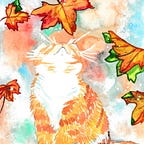Autumn Festivals of Latvia
Abjumidas
The autumn time holidays are pretty similar in the Baltic countries such as Estonia, Latvia and Lithuania. In Latvia festival, Abjumidas began the autumn season. Abjumidas was celebrated to honour the god Jumis. He was the pagan god of harvest and fertility and he was celebrated during autumn equinox between the 22nd and 24th of September.
Mikeli
The first of October was Mikeli. The day of St Michael and is similar to the Finnish Mikonpäivä. The day was named after both the Catholic Saint and the archangel Michael. It is very likely that the original Mikeli was a nature spirit. In Latvian folk belief, St Michael was the receiver of souls. Before the arrival of Christianity in Latvia, that was the job of the god Jumis. In both Finland and in Latvia Mikeli was the gate to winter and all the farm work had to be finished by Mikeli.
Velu Laiks
In Latvia, people believed in dividing time. A period in autumn when all the spirits of the dead wandered on the earth. Velu Laiks means the time of the dead and it was followed by Ledus Likes. Time of the ice. After Ledus Likes it was safe to walk on ice.
Martini
Then there was the day of St Martin which in Latvia was known as Martini. Martini also known as Martindiera was celebrated on November 10th. In Finland the day is known as Martinpäivä and in Estonia as Mardipäev. Martini was named after the Catholic Saint Martin of Tours and also sometimes after Martin Luther. The founder of Lutheranism. The day of St Martin is celebrated all over Europe but the holiday itself is way older and the name of it is based on the French word morti and Latin mori meaning death. In Pre-Christian Latvia, Martini was celebrated to honour the horse god Martinš. He was a dual god. In the springtime he would turn into god Ūsiņš.
During the night of Martini, young ladies threw their skirts onto the floor before going to bed and in the dream, their future spouse would pick it up. There have been many kinds of rituals to celebrate this special day. One that I found was a protection ritual for the horses where a rooster was sacrificed. On the eve of Martini the horse’s mouth was touched with a rooster and then the rooster was lifted towards the sun. Blood of the rooster was dropped into the horse oats. Latvians worshipped the sun goddess Saule so the rooster was a sacrificial gift for the goddess. Fortunately, this custom is not practised in modern-day Latvia. Festivities included masquerades, parades, sleigh riding, dances and preparing lots of food. There was also Marti parades going around in Martini. Big Marti´s were grown-ups and small Marti´s were children. Marti´s were people who painted their faces and dressed up as spirits of the dead. These parades were common in other countries as well, like Austria, Germany, Finland, Netherlands, Sweden and Estonia (just to name a few).
Previously published here
Subscribe to my YT Channel for more videos: https://www.youtube.com/NiinaNiskanen
If you enjoy reading my content, consider subscribing to my feed. Also, if you are not a Medium member and you would like to gain unlimited access to the platform, consider using my referral link right here to sign up. It’s $5 a month and you get unlimited access to my articles and many others like mine. Thanks
